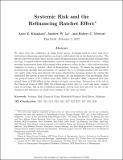| dc.contributor.author | Khandani, Amir E. | |
| dc.contributor.author | Lo, Andrew W | |
| dc.contributor.author | Merton, Robert | |
| dc.date.accessioned | 2017-05-03T15:55:02Z | |
| dc.date.available | 2017-05-03T15:55:02Z | |
| dc.date.issued | 2012-11 | |
| dc.date.submitted | 2012-05 | |
| dc.identifier.issn | 0304-405X | |
| dc.identifier.issn | 1879-2774 | |
| dc.identifier.uri | http://hdl.handle.net/1721.1/108638 | |
| dc.description.abstract | The combination of rising home prices, declining interest rates, and near-frictionless refinancing opportunities can create unintentional synchronization of homeowner leverage, leading to a “ratchet” effect on leverage because homes are indivisible and owner-occupants cannot raise equity to reduce leverage when home prices fall. Our simulation of the U.S. housing market yields potential losses of $1.7 trillion from June 2006 to December 2008 with cash-out refinancing vs. only $330 billion in the absence of cash-out refinancing. The refinancing ratchet effect is a new type of systemic risk in the financial system and does not rely on any dysfunctional behaviors. | en_US |
| dc.language.iso | en_US | |
| dc.publisher | Elsevier | en_US |
| dc.relation.isversionof | http://dx.doi.org/10.1016/j.jfineco.2012.10.007 | en_US |
| dc.rights | Creative Commons Attribution-NonCommercial-NoDerivs License | en_US |
| dc.rights.uri | http://creativecommons.org/licenses/by-nc-nd/4.0/ | en_US |
| dc.source | SSRN | en_US |
| dc.title | Systemic risk and the refinancing ratchet effect | en_US |
| dc.type | Article | en_US |
| dc.identifier.citation | Khandani, Amir E.; Lo, Andrew W. and Merton, Robert C. “Systemic Risk and the Refinancing Ratchet Effect.” Journal of Financial Economics 108, no. 1 (April 2013): 29–45. © 2012 Elsevier B.V. | en_US |
| dc.contributor.department | Massachusetts Institute of Technology. Department of Electrical Engineering and Computer Science | en_US |
| dc.contributor.department | Sloan School of Management | en_US |
| dc.contributor.department | Sloan School of Management. Laboratory for Financial Engineering | en_US |
| dc.contributor.mitauthor | Lo, Andrew W | |
| dc.contributor.mitauthor | Merton, Robert | |
| dc.relation.journal | Journal of Financial Economics | en_US |
| dc.eprint.version | Author's final manuscript | en_US |
| dc.type.uri | http://purl.org/eprint/type/JournalArticle | en_US |
| eprint.status | http://purl.org/eprint/status/PeerReviewed | en_US |
| dspace.orderedauthors | Khandani, Amir E.; Lo, Andrew W.; Merton, Robert C. | en_US |
| dspace.embargo.terms | N | en_US |
| dc.identifier.orcid | https://orcid.org/0000-0003-2944-7773 | |
| dc.identifier.orcid | https://orcid.org/0000-0003-1133-2484 | |
| mit.license | PUBLISHER_CC | en_US |
